
A refinery and rail tankers for liquefied natural gas storage and transportation
iStock
Natural gas is no more “natural” than any other fossil fuel, and it’s not clear how that moniker became associated with fossil gas. When the English-speaking world started burning the stuff for light in the 1790s, people just called it gas. (When someone lies so insistently that you feel like you’re losing your mind, you are being “gaslighted” not “natural gaslighted.”) The phrase natural gas entered the language in 1825, in a minor magazine, and it didn’t become common until the late 19th century.
Public polling shows that the phrase natural gas gives people the false impression that it’s safe for humans and the environment. This raises the question: Did the gas industry work to make this the accepted phrase? There is little evidence either way, but don’t put it past them—gas producers have historically engaged in semantic influence. An employee of the American Gas Association popularized the phrase “cooking with gas” in the 1930s, when gas was vying with electricity to become America’s stove fuel of choice. The association worked to get comedian Bob Hope to use it, and it became so common that even Daffy Duck was accidentally endorsing gas by the 1940s. These campaigns have by no means ceased. During the Trump administration, efforts were made to rechristen liquefied natural gas (LNG) as “freedom gas.” It has even been revealed that social media influencers are being paid to convince millennials and Generation X that gas stoves are cool. (#CookingWithGas)
Natural gas may be a triumph of marketing, but the fact is that gas is a major contributor to air pollution, water pollution, and climate change.
What is natural gas?
Natural gas (also known as fossil gas, fracked gas, and simply, gas) is a fossil fuel: ancient plant material deposited in an oxygen-poor environment and cooked over millions of years by heat from the earth. The type of plant and the extent of the cooking determines whether the end product is coal, oil, or gas.
When it’s first extracted from the ground, natural gas contains several components. The main ingredient—what energy companies are after—is methane (CH4). There is also carbon dioxide and water vapor. Some combination of ethane, butane, pentane, and propane are present in liquid form, which is why the stuff that comes directly out of the ground is called wet natural gas.
According to the U.S. Energy Information Administration (EIA), in the United States, gas is most commonly used for electricity generation, as fuel and raw material in industrial processes like plastic production, and in commercial and residential buildings for space and water heating, cooking fuel, and to dry clothes.
Natural gas extraction
Natural gas is found buried beneath millions of years of silt, sand, and rock. The deposits vary in size, and the technique of extraction varies accordingly. Natural gas deposits are sorted into two major categories, conventional and unconventional.
Conventional gas is trapped within large, rock-bound chambers. Engineers locate these chambers with seismic surveys—broadcasting deafeningly loud sound waves into the earth and listening for differences in how the waves bounce back. Those differences provide a map of the density of the surveyed area. This noisy process can be carried out with explosives or thumper trucks (which don’t look nearly as adorable as their name suggests).
Extracting conventional gas is similar to extracting oil. A hole is drilled into the rock, giving the gas an escape route to the surface. When it arrives there, the gas is directed into pipelines and pushed to processing plants, where the methane is separated from the other chemicals.
Tight gas, like conventional gas, is also sequestered in rock formations, typically sandstone. Unlike the large chambers in which conventional gas hangs out, tight gas is bound up in lots of teeny, tiny spaces in the rock, called pores. The pores are only a few nanometers across. Similarly, shale gas is trapped between layers of shale formations with low permeability.
There’s no such thing as a nano drill equipped with a nano drill bit, so how does one extract these types of unconventional gas from such small spaces? This is where hydraulic fracturing, or fracking, comes in. Energy companies pump a cocktail of water, sand, and chemicals into the rock under pressure. (We don’t know exactly which chemicals are involved—there are no federal disclosure rules and most states allow companies to keep at least some portion of their special sauce secret.) The liquid breaks up the rock formation, allowing the gas to flow out of the pores and into wells that funnel the gas to the surface.
Fossil fuel producers have used fracking to extract natural gas since the mid-20th century, but the process became more efficient between the late 1980s and early 2000s thanks to billions of dollars in federal funding and a number of substantial regulatory waivers obtained by the industry. This enabled companies to access gas deposits that weren’t profitable to extract in the past. At that point, fracking spread rapidly. In fact, the United States surpassed Russia as the leading gas producer in the world, and has maintained that position since 2012—mostly due to the rise of fracking. According to the EIA, the United States produced 26.3 trillion cubic feet of shale gas in 2020, with fracking now representing more than three-quarters of all U.S. gas production.
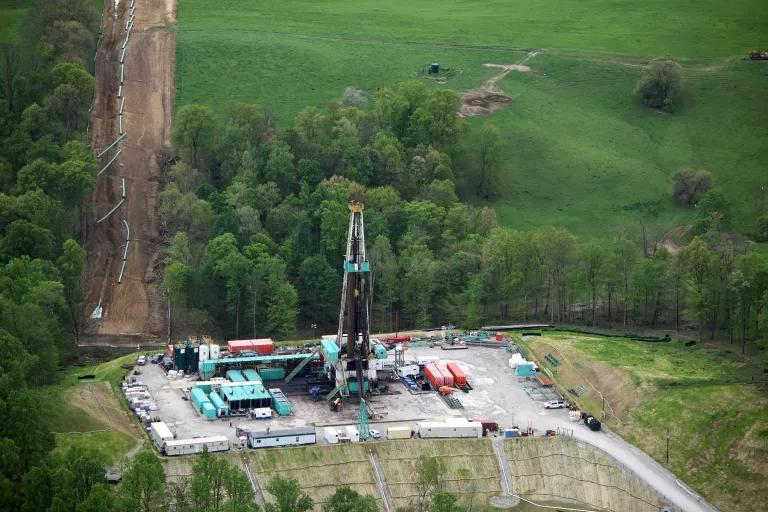
A fracking rig, with pipeline construction in the background, in Malaga, Ohio, in May 2017
Ted Auch/FracTracker, CC-BY-NC-ND 4.0
Problems with natural gas
Climate change
While some claim that natural gas emits less climate-warming pollution than coal or oil, the truth is more complicated. Gas doesn’t yield as much greenhouse gas as coal or oil does when burned but that’s not the only way greenhouse gases escape into the atmosphere. Before it’s burned, gas leaks at every part of its journey: from the well, during transportation along pipelines, at power plants, and in the homes and businesses where it's burned. That means that at every step, copious amounts of methane—the second most significant climate pollutant—are released into the air, as producers either deliberately vent methane or accidentally allow it to escape from active or abandoned wells or other infrastructure. An accurate accounting of the latter issue, gas infrastructure leakage, is needed to fully grasp the impact of gas on our climate and air quality.
Methane is among the most powerful greenhouse gases known to science, with 80 times the heat-trapping potential of carbon dioxide over the first 20 years after it is emitted into the atmosphere. Indeed, the Sixth Assessment Report from the Intergovernmental Panel on Climate Change (IPCC) noted that methane has caused about two-thirds as much of our current warming as carbon dioxide. Energy production (fracking and associated activities) and energy use are by far the leading sources of methane emissions, easily outpacing agriculture and landfills, as a large amount of methane escapes into the atmosphere at the wellhead and from pipes. Reducing these massive methane emissions from the fossil fuel industry—and moving away from gas—is a critical step in the fight against climate change.
“To be clear, it’s not just the greenhouse gasses released from the production and transmission of gas that make it bad for our planet,” says Amanda Levin, an NRDC policy analyst. “The combustion of gas for energy has a high carbon footprint as well.” According to the EIA, in 2020, the total carbon footprint of gas represented almost twice that of coal in the United States (1,647 million metric tons of CO2 from gas consumption versus 875 million metric tons from coal), accounting for more than 36 percent of energy-related CO2 released in the country. Total carbon pollution from gas power plants has more than doubled in the last 15 years. “Gas is the largest source of carbon pollution in the industrial sector,” adds Levin.
Air pollution
The gas industry also emits nitrogen oxides and volatile organic compounds. All of these chemicals facilitate the creation of ground-level ozone, which contributes to several lung diseases and increases susceptibility to respiratory infection.
People who live near oil and gas wells experience elevated rates of poor pregnancy outcomes (birth defects, preterm birth, and fetal death), cancer, respiratory and cardiovascular problems, and asthma exacerbation. For this reason, public health advocates are urging cities and states to ban drilling close to communities, and the city of Los Angeles is moving toward outlawing drilling within city limits.
Researchers at UCLA found that gas appliances in our homes—including stovetops, heaters, and clothes dryers—are worsening indoor and outdoor air quality with pollutants, including carbon monoxide, nitrogen oxides, formaldehyde, and fine particulate matter.
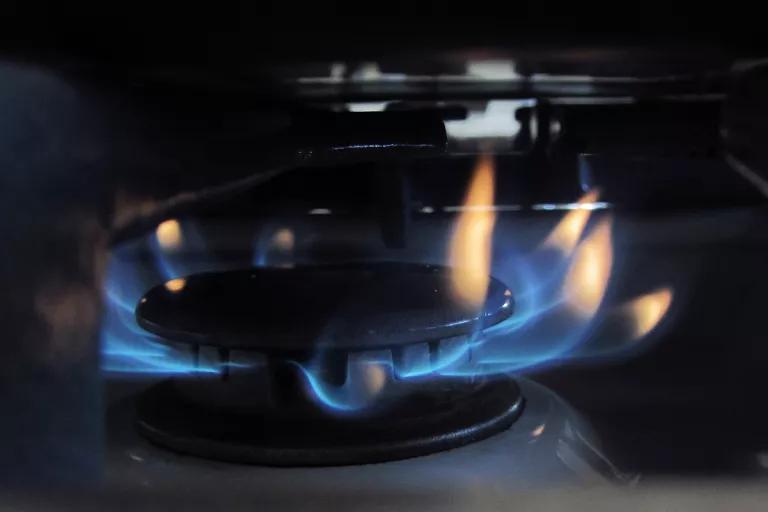
Gas-powered home appliances, such as stovetops, can worsen indoor air quality.
Lisa Redfern
Water pollution
To frack a single well, energy companies can use million gallons of freshwater. In most cases, the water (along with added chemicals) is pumped deep underground, removing it from the earth’s background water cycle and reducing the availability of drinking water. “When the water is recovered from the fracking process, it is too contaminated to be treated and returned to the water cycle, never mind safe to drink,” says Kimberly Ong, a senior attorney at NRDC. “Also, since energy companies can’t fully control where the dirty water used for fracking flows, the process threatens nearby sources of drinking water.”
Fracking wastewater can be radioactive, corrosive, and toxic to humans and wildlife. While companies do not need to disclose their full list of ingredients, the pollutants in the wastewater can include salts, organic hydrocarbons (oil and grease), inorganic and organic additives, and naturally occurring radioactive material. As found in NRDC’s report “In Fracking’s Wake,” at least 29 chemical additives in fracking water have been identified as of particular concern for human health—and more than a dozen are probable or known human carcinogens. “Some additives can also interact with disinfectants at drinking water plants to form cancer-causing chemicals,” notes Ong.
In many communities, it has become clear that federal and state regulations have not kept up with the dramatic rise in fracking—and the nature of investigating groundwater pollution makes it even more difficult to track its impacts, like in the case of Pavillion, Wyoming. Many of the pollutants in fracking wastewater are not commonly tested for in commercial labs.
Community impacts
All of these harms have disproportionate impacts on poor communities and communities of color. Overwhelming data prove that people of color inhale polluted air at inordinately high rates. And, as recent drinking water crises have proven, low-income communities are the first to suffer when drinking water monitoring becomes lax. Natural gas infrastructure itself also poses a threat to the most vulnerable communities: The industry typically builds its high-polluting processing plants near homes for low-income people and people of color.

Umatilla tribal leader Cathy Sampson Kruse (left) and her daughter Mariah Sampson leading a prayer together at a 'No LNG' rally in Salem, Oregon on May 26, 2015
Alex Milan Tracy/AP Photo
“Industry has been quite deliberate in its willingness to leverage its political, economic, and regulatory clout to choose to drill where it wants,” says Bobby McEnaney, director of NRDC’s Dirty Energy Project. “In the case of fracking, this has meant that rural, Indigenous, and BIPOC communities have suffered the most. The indiscriminate use of eminent domain to force landowners, such as farmers, to allow drilling and pipelines on their land is a standard business model for frackers. Add in the federal and state exemptions from environmental laws that have been deliberately written for fracking operations, and this results in many communities finding themselves even more marginalized in being able to assert their rights to a clean environment.”
For all of these reasons, coalitions including NRDC have been pushing, state by state, for fracking bans. California and New York have already responded, and a fracking ban in the Delaware River Basin covers parts of Delaware, Maryland, New Jersey, and Pennsylvania.
Feeding plastic pollution
When producers drill for methane, they also extract ethane from the ground. Ethane is a primary component in plastics production.
The U.S. fracking boom has flooded the world with ethane, and is helping to fuel the incredible increase in global plastics production. Even with gas prices sagging at times in recent years, the sale of ethane to plastics makers propped up several gas producers. “You can think of plastic as a kind of subsidy for fracking,” Steven Feit, an attorney at the Center for International Environmental Law, told Yale Environment 360.
You could also think of gas as a kind of subsidy for plastics. As long as ethane is a cheap by-product of methane production, there will be very little cost to manufacture the plastics that are plaguing the world’s waterways, clogging landfills, and harming our health.
Earthquakes
The deposition of wastewater deep underground during natural gas production pressures rock formations, causing them to shift suddenly. The incidence of magnitude three or greater earthquakes increased 40-fold between the late 20th century and the last several years in the central United States. In Oklahoma, where fracking has surged since 2009 and the rate of magnitude three or greater earthquakes outpaced even California from 2014 to 2017, Stanford University geophysicists found that fracking for oil and gas is the prime suspect for causing such an increase. According to the USGS, the largest-known fracking-induced earthquake in the United States was a magnitude four quake that occurred in Texas in 2018. Some of these man-made earthquakes have been large enough to cause property damage and injuries.
Natural gas pipelines
Pipelines are easily the most common method of transporting natural gas domestically. The United States currently has more than 300,000 miles of pipelines dedicated to carrying natural gas. Along the way are compressor stations, which maintain the pressure that pushes the gas through the lines.
There are three types of gas pipeline. Narrow gathering pipelines collect gas from the hundreds of thousands of wellheads spread across the country. The gathering pipelines deliver the gas to either a processing facility or a large-diameter transmission pipeline, which itself connects to a processing facility. The gas then continues to narrow pipes again, called distribution pipelines, to be delivered to consumers. You can think of the gas delivery system like a tree (narrow roots, thick trunk, narrow branches), only much, much dirtier.
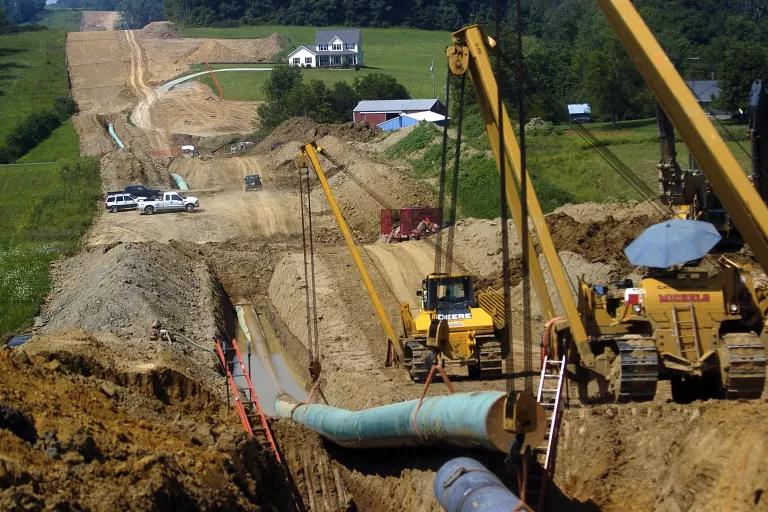
Construction of the Rocky Express Pipeline in Lancaster, Ohio in 2009. The gas pipeline system stretches 1,679 miles from Rio Blanco County, Colorado, to Monroe County, Ohio.
Ty Wright/Bloomberg via Getty Images
Pipeline regulation
Any new pipeline project that intends to cross state lines must be reviewed by the Federal Energy Regulatory Commission (FERC), an independent agency that has the authority to issue a “certificate of public convenience and necessity” for the construction and operation of gas pipelines under the Natural Gas Act. In the past, environmental and community groups have criticized FERC for rubber-stamping every project that has applied for a certificate. Partially thanks to increased criticism from the courts, the agency has begun to include climate change considerations in determining whether a pipeline gets the green light. FERC is also auditing the policies that guide its pipeline reviews—a process it began in 2018.
“This audit includes possible changes to how FERC considers a pipeline’s greenhouse gas emissions, whether a pipeline is needed to serve the public interest, and how a pipeline affects landowners and environmental justice communities,” explains Gillian Giannetti, an NRDC attorney. “This is important,” she adds. “Because pipelines can last for 50 years or more, the construction of pipelines today could lock in our reliance on fossil fuels decades into the future.”
While FERC is conducting this audit, it also created an Office of Public Participation to better bridge the gap between the agency and the public, soliciting feedback on how it should improve. “Some important suggestions include facilitating more public participation into the process and hosting site visits where concerned citizens can see how a proposed pipeline will affect their communities—as well as ensuring that the needs of historically exploited communities, including both state and federally recognized Indigenous tribes, are considered,” adds Giannetti.
FERC approval is not the only requirement before a gas pipeline is built. For example, pipeline developers generally also need permits from the U.S. Fish & Wildlife Service, the Army Corps of Engineers, and/or the USDA Forest Service. When pipelines cross federal land, developers must also get approvals from the Bureau of Land Management.
States also have authority over the construction and operation of gas pipelines. “Under the Clean Water Act, for instance, states can block pipelines that have not demonstrated that they will comply with state water quality standards and requirements,” says Morgan Johnson, an NRDC attorney. “The Clean Air Act also allows states to block gas compressor stations by denying certain air permits.”
Failure to obtain one of these permits has led to the cancellation of several high-profile pipelines, including the PennEast Pipeline and the Williams Pipeline. “These additional permits also offer opportunities to raise concerns with a particular project to forums other than FERC,” explains Johnson. For example, before the controversial Atlantic Coast Pipeline met its demise in 2020, environmental and community advocates drew attention to its direct path through the Appalachian Trail, which required National Park Service and Forest Service reviews. It also required the state of Virginia to assess the air emissions connected to the project owners’ plan to put a compressor station in Union Hill, Virginia, a historic site home to many descendants of freed enslaved people.
There are several more pipelines already under construction facing similar pushback from the public. The Biden administration could easily halt these projects, like the Mountain Valley Pipeline across Appalachia, by reversing their approvals.
Other natural gas transportation methods
While domestic transportation of gas relies overwhelmingly on pipelines, gas is also moved by truck, rail, and ship. Before being shipped over land or sea, it is typically converted into a liquid form, known as liquefied natural gas, which is compressed and/or cooled to the unbelievably low temperature of -259 degrees Fahrenheit, or -161 degrees Celsius.
There are a couple of major problems associated with these transportation methods. “First, the energy required to cool gas into its liquid state, plus the energy required for overland or oversea transport, and finally converting the liquid gas back into a gaseous state, is immense” says Levin. “This process erases whatever climate advantage gas might have had over other forms of fossil fuels.”
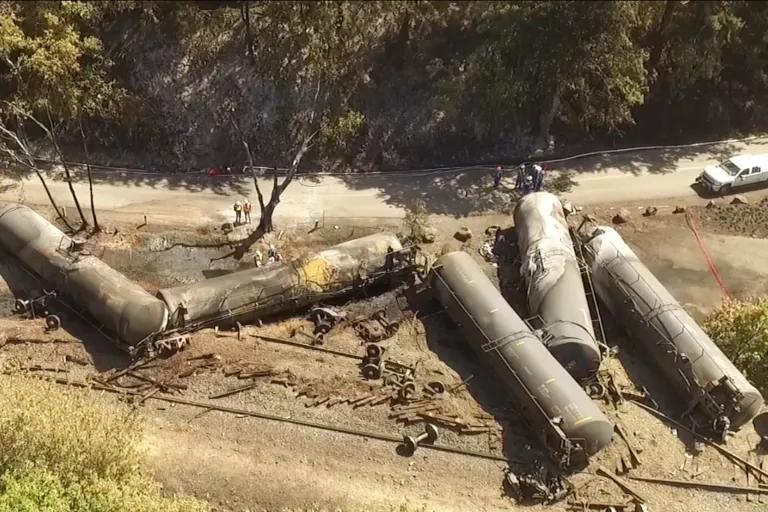
Burnt oil tankers damaged in a fire following a train derailment in Mosier, Oregon, on June 3, 2016. US safety officials say they've seen slow progress in efforts to upgrade or replace tens of thousands of rupture-prone rail cars used to transport oil and gas, despite a string of fiery derailments.
Brent Foster/AP
Second, a truck or train densely packed with fossil fuel is essentially a bomb. The liquefied natural gas from just one rail tank car could be enough to destroy a city. Just 22 tank cars would have enough energy to match that of the Hiroshima bomb. “In many cases, these bombs are driven through populated communities to get from processing facilities to export terminals or consumers,” says Ong. The proposed Gibbstown Logistics Center, a liquefied natural gas facility to be built on the Delaware River, is a good example. “The project would entail driving fracked gas more than 200 miles through residential neighborhoods near and through Philadelphia.”
Natural gas disasters
If that doesn’t worry you, take a look at the history of natural gas infrastructure—this stuff has a troubling tendency to blow up. In the United States alone, gas compressor stations, processing facilities, and pipelines are responsible for explosions in 2012, 2013, 2015, 2016, and 2019. In many cases, workers were killed or severely injured.
The 2015 Aliso Canyon gas leak near Los Angeles released over 95,000 tons of methane into the atmosphere, placing more than 35,000 people at risk in one of the single-worst climate-related disasters in human history. (Leaks persist to this day.) Not long after, a pipeline in Alaska ruptured, leaking 210,000 to 310,000 cubic feet of gas a day at some points. Those leaks will affect the global climate for decades.
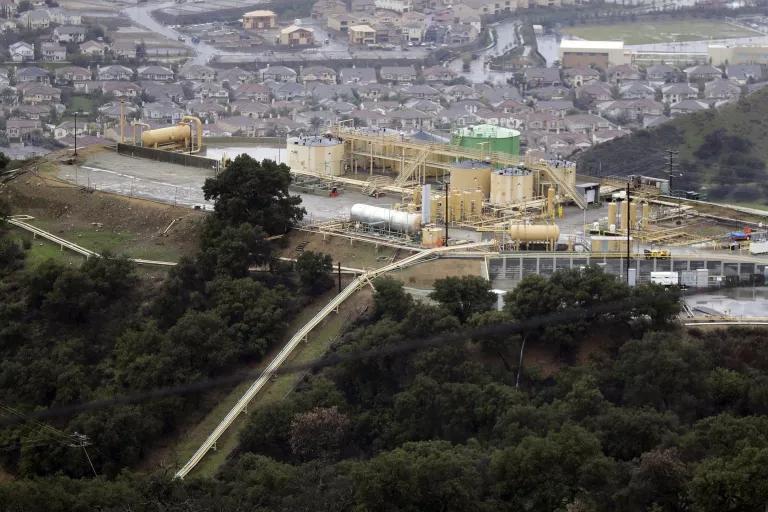
A gas gathering plant at the Southern California Gas Company's Aliso Canyon storage facility near the Porter Ranch neighborhood of Los Angeles in January 2017
Jae C. Hong/AP Photo
In 2021, a blaze fed by a leaking gas pipeline in the Gulf of Mexico created the unimaginable image of an ocean on fire. Nicknamed “the eye of fire,” the disaster was only a short distance from an oil platform.
Alternatives to natural gas
Gas proponents have touted it as a “bridge fuel,” an immediately deployable energy source that is cleaner than coal and can power the world’s economy until renewables are ready to take over. But here’s the problem: “The bridge fuel argument dates to the early 1970s and no longer holds water,” says Sheryl Carter, who leads NRDC’s work on the power sector. “Renewables are now cheaper than gas almost everywhere in the United States—and energy efficiency measures were always cheaper.”
“Nearly five decades of industry rhetoric about gas being a bridge fuel doesn’t make it any cleaner or more viable,” says McEnaney. “We need pathways, not bridges. On cost alone, we have seen that renewables and efficiency measures have gas beat. There are even several gas drilling operations that have perversely built their own wind and solar facilities to power drilling operations, since it is cheaper than using gas.”
Indeed, utility-scale wind and solar energy are now cheaper than energy from gas or coal. The trend lines should terrify gas producers: Over the last decade, the cost of energy from wind has dropped 70 percent, and the cost of solar power has dropped 89 percent. “If things continue this way, there will be few arguments left in favor of gas—or any fossil fuel,” says Carter. “Renewables are ready to take over.”
This NRDC.org story is available for online republication by news media outlets or nonprofits under these conditions: The writer(s) must be credited with a byline; you must note prominently that the story was originally published by NRDC.org and link to the original; the story cannot be edited (beyond simple things such as grammar); you can’t resell the story in any form or grant republishing rights to other outlets; you can’t republish our material wholesale or automatically—you need to select stories individually; you can’t republish the photos or graphics on our site without specific permission; you should drop us a note to let us know when you’ve used one of our stories.
The U.S. is the world’s largest exporter of dangerous liquefied natural gas.
Tell the Biden administration you support its pause on LNG exports—and that you’re counting on it to phase out all dirty fuels and to fight the climate crisis.
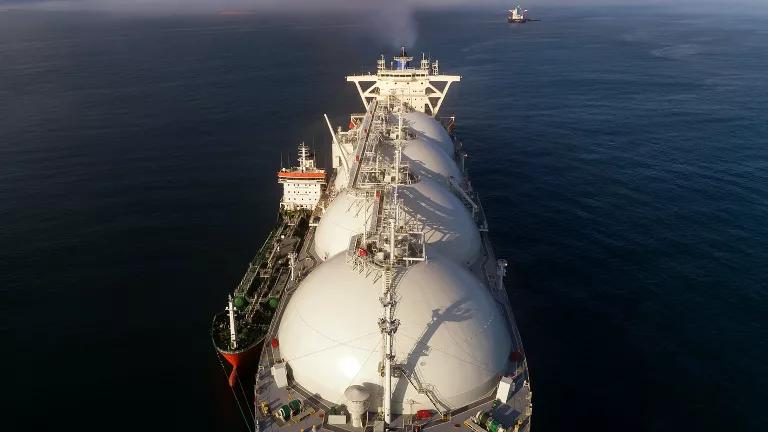
Help protect communities from dangerous liquefied natural gas!
Liquefied natural gas (LNG) is a dangerous substance composed primarily of methane, a greenhouse gas 80 times more potent than carbon dioxide. The Biden administration has paused LNG exports—and now we must urge it to phase out all climate-wrecking fuels.
Clean Air Warrior
The Uinta Basin Railway Would Be a Bigger Carbon Bomb Than Willow
The Clean Air Act 101
Clean Air Warrior
The Uinta Basin Railway Would Be a Bigger Carbon Bomb Than Willow
The Clean Air Act 101
Clean Air Warrior
The Uinta Basin Railway Would Be a Bigger Carbon Bomb Than Willow
The Clean Air Act 101
Clean Air Warrior
The Uinta Basin Railway Would Be a Bigger Carbon Bomb Than Willow